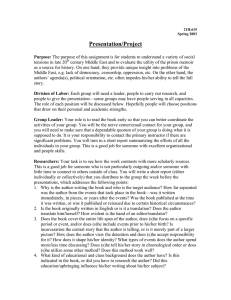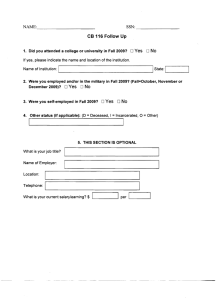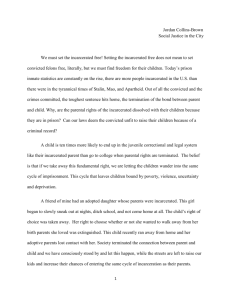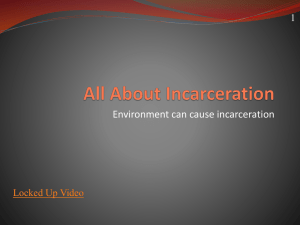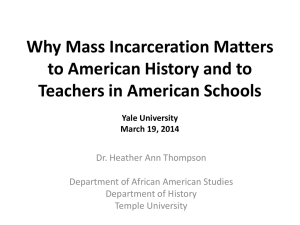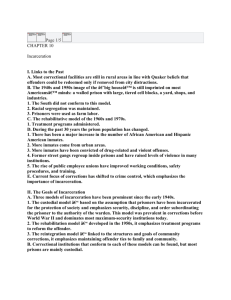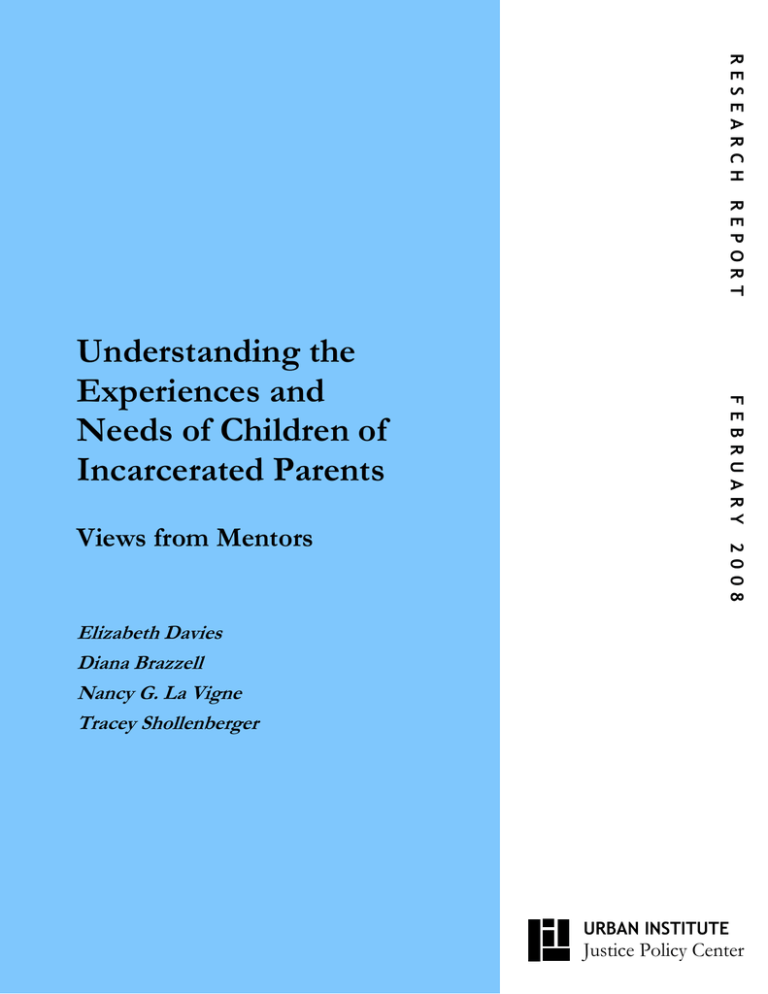
RESEARCH
REPORT
2008
Views from Mentors
FEBRUARY
Understanding the
Experiences and
Needs of Children of
Incarcerated Parents
Elizabeth Davies
Diana Brazzell
Nancy G. La Vigne
Tracey Shollenberger
URBAN INSTITUTE
Justice Policy Center
URBAN INSTITUTE
Justice Policy Center
2100 M Street NW
Washington, DC 20037
www.urban.org
© February 2008. The Urban Institute. All rights reserved. Except for short quotes, no part of this report
may be reproduced or utilized in any form or by any means, electronic or mechanical, including
photocopying, recording, or by information storage or retrieval system, without written permission from the
Urban Institute.
The Urban Institute is a nonprofit, nonpartisan policy research and educational organization that
examines the social, economic, and governance problems facing the nation. The views expressed are
those of the authors and should not be attributed to the Urban Institute, its trustees, or its funders.
This research was funded by the Annie E. Casey Foundation. We thank them for their generous support
and guidance.
We also would like to thank the dedicated staff members of Big Brothers Big Sisters in Milwaukee,
Baltimore, and Washington, D.C., for their continued involvement and help on this project, along with the
mentors who volunteered their time to participate in our focus groups.
Contents
Introduction................................................................................................................................................... 1
Focus Group Methods................................................................................................................................... 1
Key Findings................................................................................................................................................. 2
A mother’s incarceration is a greater disruption in a child’s life than a father’s incarceration...........................3
Children with incarcerated parents often face difficult living situations.............................................................3
Maintaining contact with a parent during incarceration is challenging. .............................................................4
The process of release and reintegration is a particularly stressful time. ............................................................5
Parental incarceration is associated with a variety of negative behavioral outcomes. ........................................5
It is unclear whether children of incarcerated parents differ from their peers. ...................................................6
Shame and stigma distinguish incarceration from other forms of parental absence. ..........................................7
Demographic variation among children impacts their reaction to the incarceration of a parent.........................8
Children with incarcerated parents need a variety of supports. ..........................................................................9
Summary ..................................................................................................................................................... 10
Appendix A: Participant Characteristics..................................................................................................... 11
Introduction
In 2007, the Annie E. Casey Foundation provided funding to the Urban Institute (UI) to undertake several
tasks that would expand current understanding of the impact of a parental incarceration on children. As part
of the project, the Urban Institute partnered with Big Brothers Big Sisters (BBBS) organizations to obtain a
qualitative perspective on the experiences and needs of children with incarcerated parents through a series
of focus groups with adult volunteers mentoring those children. The following report describes the results of
the focus groups, with particular attention to differences within this population and to comparisons to similar
children who do not have a parent involved in the criminal justice system.
The focus groups drew on participants’ experiences working with children of incarcerated parents to
explore a series of questions:
•
What are the family situations of these children?
•
What were their relationships with their parents prior to incarceration?
•
Who is caring for them now?
•
How is the parent-child relationship maintained or disrupted during incarceration?
•
How does parental incarceration affect children emotionally, behaviorally, and
developmentally?
•
What are the needs and challenges of children with incarcerated parents?
•
How do these needs differ from those of other at-risk children?
This report describes the focus group methodology and then explores several key themes that emerged
during the focus groups in response to the questions outlined above. Although our findings cannot be
generalized to the entire population of children with incarcerated parents, they raise valuable questions and
can provide a launching point for future research on the impact of parental incarceration. Throughout the
report, effort is made to synthesize and present insights in a way that is useful to individuals working in the
field as well as to those conducting research on this population of children.
Focus Group Methods
For this project, UI researchers partnered with Big Brothers Big Sisters (BBBS) programs in Baltimore,
Maryland; Milwaukee, Wisconsin; and Washington, D.C. A BBBS coordinator from each site compiled a list
of those individuals who had mentored a child with a currently or formerly incarcerated parent and whose
mentoring relationship with that child had lasted at least six months. Staff members from UI and BBBS
successfully recruited 31 mentors and convened four focus groups in Baltimore, two in Milwaukee, and one
in Washington. A detailed description of the participants and their Little Brothers and Sisters 1 is provided in
Appendix A.
1
Staff and volunteers involved in the Big Brothers Big Sisters program commonly refer to the mentors as “Bigs,”
short for Big Brothers or Big Sisters, and the mentees as “Littles,” short for Little Brothers or Little Sisters. This report
adopts this terminology.
1
The focus groups were conducted between June and December 2007. Some groups were
intentionally restricted to either mentors of children with incarcerated mothers or mentors of children with
incarcerated fathers in order to examine how the gender of the parent influences child outcomes. Each
focus group began with an introduction by UI staff members, who clarified the purpose of the study,
described how the focus group would be conducted, and explained the informed consent procedures.
Participation was voluntary and all findings are reported in the aggregate or in a way that does not identify
individual mentors or children. Focus group participants also completed background forms providing basic
demographic data on themselves and their Littles. The focus group discussions averaged 90 to 120 minutes
in length, which allowed time for the UI moderator to cover the questions described in the introduction while
developing a rapport with participants. One UI staff member served as moderator for each group while
another took detailed notes on the discussion.
In order to supplement findings from the focus groups, UI also interviewed six BBBS staff members
in Milwaukee and Baltimore to provide context on the BBBS program and to gain further insights into the
research questions. Some of the staff members interviewed also had previous experience mentoring
children with incarcerated parents.
Key Findings
As would be expected, participants provided differing perspectives in response to many of the questions we
raised. Nonetheless, several themes consistently emerged across the focus group discussions and
interviews at the three sites. Our discussion of findings is organized around these nine themes, which can
be summarized as follows:
•
A mother’s incarceration is a greater disruption in a child’s life than a father’s incarceration.
•
Children with incarcerated parents often face difficult living situations.
•
Maintaining a relationship with a parent during incarceration is challenging.
•
The process of release and reintegration is a particularly stressful time.
•
Parental incarceration is associated with a variety of negative behavioral outcomes.
•
It is unclear whether children of incarcerated parents differ from their peers.
•
Shame and stigma distinguish incarceration from other forms of parental absence.
•
Demographic variation among children impacts their reaction to the incarceration of a
parent.
•
Children with incarcerated parents need a variety of supports.
The project was exploratory in nature and, as with all focus groups, was designed to provide
qualitative, anecdotal data. Findings are limited to the groups that were convened and should not be
generalized to the broader population of children who have a parent incarcerated. Nonetheless, the findings
raise some valuable questions and suggest areas for further exploration. This report attempts to present the
ideas and perspectives that were most widely discussed and agreed upon, and to indicate how
representative these perspectives are among participants.
2
A mother’s incarceration is a greater disruption in a child’s life than a father’s incarceration.
Regarding the dynamics and impact of parental incarceration, it was clear from the focus group discussions
that considerable differences exist between the incarceration of mothers and fathers. In general, mothers
played a much greater role in their children’s lives prior to incarceration than did fathers, and often served
as their children’s primary caregivers. As a result, the departure of the mother disrupts children’s daily lives
and usually places them in the care of grandmothers, aunts, or other female relatives. One mentor
described the incarceration of his Little’s mother as completely dissolving the entire family structure, which
had to be rebuilt around the grandmother. “The incarceration had a tremendous effect,” the participant
noted. “[Even though] the grandmother provided everything that was needed, it was difficult for my Little to
have had that normal structure and then be torn away from it.” 2
In contrast, mentors reported that fathers are often absent or played less of a role in their children’s
lives prior to incarceration. Thus, Bigs indicated that children with incarcerated fathers are living in relatively
stable, positive environments that were not as greatly disrupted by the father’s departure. One Big
suggested that because her Little never lived with her father, her life wasn’t really changed by the
incarceration: “She loves her father and likes it when he’s out, but it doesn’t upset daily life.”
Although children’s strong relationships with their mothers prior to incarceration tended to result in
greater distress and upheaval upon her departure, it also supported communication during her confinement.
Most mentors indicated that their Littles want to maintain bonds with their incarcerated mothers and are
more likely than children with incarcerated fathers to have contact with their parent during the incarceration.
Children with incarcerated fathers tend to have far less contact and are more ambivalent about maintaining
a relationship with their fathers, both in prison and after release.
Children with incarcerated parents often face difficult living situations.
Mentors consistently praised those caring for children in a parent’s absence. The caregivers, typically
mothers, grandmothers, or other female relatives, were often described as hard-working and dedicated to
seeking the best for the children in their care. Despite the best efforts of caregivers, however, children often
face difficult living situations. Some caregivers do not have sufficient money or time to raise the children in
their care. Participants explained that taking in an extra child represents a significant hardship for many
caretakers, particularly grandparents with fixed incomes and, often, deteriorating health. Other participants
cited the loss of support from the incarcerated parent as a significant strain on the family’s finances. Even
when caregivers are relatively financially stable, they often have limited time to spend with the children;
many mothers of children with incarcerated fathers were single parents who worked long hours to support
their families.
As mentioned above, most children of incarcerated parents are being cared for by mothers,
grandmothers, or other female relatives. Regardless of whether the mother or father is behind bars, many
of these children did not live with their fathers before, during or after the incarceration. While the specific
composition of households varies, the majority of inhabitants are female, as are many of those in the
2
Quotes used in this report are based on notes taken throughout the focus group discussion and may be paraphrased.
3
surrounding neighborhoods. One Big noted a general absence of men in his Little’s apartment complex,
while another commented that most of the males in his Little’s extended family are in jail. Some participants
speculated that a female-dominated living environment is difficult for boys, with one Big describing his Little
brother as “yearning for male interaction.”
In addition to the lack of resources and male role models described above, the living situations of
children with incarcerated parents often lack stability. Children frequently move following the incarceration
of their parent, particularly if that parent is their mother. One Big noted that his Little had lived in seven
households within a seven-month period. The households that children of incarcerated parents inhabit often
contain several other children and relatives. One participant reported that at one point, her Little was living
in a two-bedroom house with 16 other people. Some of the people within these households are likely to be
transitory, with one Big commenting that he frequently sees people passing through the house. Children
may also face additional moves once the incarcerated parent is released. The constantly changing
landscape of places and people may weaken otherwise supportive social ties and lead to, as one big
observed, “insecurity about not having a traditional family.” One Big noted that her Little is acutely aware of
the instability and had commented that “people were always in and out of her life.”
Maintaining contact with a parent during incarceration is challenging.
A large number of mentors did not know how much contact their Little had with the incarcerated parent,
usually because the Little did not mention it. For those that did know about the level of communication, or at
least could speculate as to its extent, most reported infrequent visits, phone calls and letters. One male
Little has frequent phone calls with his mother, but has only visited her once in prison. Transportation was
cited as the most common barrier to maintaining contact with a parent behind bars. Bigs also described
caretakers who are either unwilling or unable to coordinate a visit, as well as an occasional lack of access
to phone service either because the parent lost phone privileges or the child’s home phone had been
disconnected. One Big remarked that her Little’s phone would sometimes be cut off, preventing the two of
them from speaking for weeks at a time.
Although some Littles have minimal contact with their parent, several of them look forward to
having a relationship with the parent upon release, particularly if the incarcerated parent was their mother.
Bigs described children who have never met the incarcerated parent or were too young to remember them
before they went away but still dream of having a relationship upon release. Others remained attached to
parents regardless of the level of parental engagement prior to incarceration. On the other hand, a number
of Littles seem to show no interest in maintaining or reestablishing a relationship with their parent,
especially in the case of incarcerated fathers. As mentioned above, children tended to have stronger
relationships with their mothers prior to incarceration than their fathers, resulting in a greater level of contact
between children and incarcerated mothers and a stronger interest in continuing the relationship during
incarceration and upon release.
Children with incarcerated fathers tend to have far less contact with their parent during
incarceration and are more ambivalent about maintaining a relationship with their father, both in prison and
after release. While some anxiously await their father’s return and “missed him terribly,” others resist
4
attempts at reunification. Many Littles remain silent on the topic around their Bigs, though one mentor noted
that his Little “always denies wanting to have a relationship with his father, but I can hear the anger in his
voice.”
The process of release and reintegration is a particularly stressful time.
The period following a parent’s release is likely to be one of disruption and disappointment. Children
sometimes have high expectations about changes that will occur in the family and in their parent’s behavior,
while parents may make promises that only cause these expectations to grow. One Big worried that her
Little’s father would not be able to follow through on all of the promises he has made to his child about what
would happen when he came out of prison. Another mentor whose Little’s mother cycles in and out of jail
described the mother as making extensive promises and statements of love only to disappear after a few
days and end up back in jail. “She paints a pretty picture for my Little, and it’s just enough to do a little more
damage,” said the Big. A BBBS staff member explained that when children continually have their
expectations built up only to be disappointed, they repeatedly have their trust broken. As a result, issues of
abandonment may surface along with an expectation of inconsistency from others in their lives.
In addition to the disappointment that can accompany the parent’s return, it is often a time of
change and uncertainty. The child may move and family dynamics shift as the parent tries to reunite with
his or her partner and other family members. Children are uncertain about the parent’s role in their life.
They may be exposed to additional risks, such as witnessing criminal activity or watching their parent slide
back into substance abuse and crime. One Big reported that the year before her Little’s father went back
into prison, the child witnessed his father’s drug relapse.
As a result of the challenges associated with release, many focus group participants and BBBS
staff members felt that a lengthy sentence was less damaging for a child than a parent who is constantly
cycling in and out of incarceration. One Big commented that the process of her Little’s father coming in and
out of jail was traumatic for her Little, who can never predict when the father would be around. In contrast,
another mentor remarked that his Little was so young when his father began a long sentence that he lost
the need for the father’s support and has built up the ability to get by without it. The Big also suggested that
the consistent lack of a father makes it easier for others to recognize gaps in the child’s support system. A
BBBS staff member agreed that it was difficult for children to have people in their lives one minute and out
the next, noting that “if they’re consistently gone, it’s almost better.” In this person’s opinion, when parents
are gone for long periods of time, children can build more trusting relationships with adults who can provide
support.
Parental incarceration is associated with a variety of negative behavioral outcomes.
Some Bigs found their Littles to be fairly resilient and to suffer from behavioral issues no more extensive
than other children their age. However, others encountered behavioral concerns and identified a variety of
negative outcomes associated with parental incarceration. These included anger, acting out, withdrawal,
lack of trust, feelings of isolation, difficulty coping with the reason for the parent’s absence, trouble in school
and with the law, and lack of respect for authority.
5
Children, especially boys, were often described as angry, rebellious, undisciplined and prone to
soliciting attention through misbehavior. One mentor noticed such changes when his Little Brother’s father
went to prison, recalling “a period when my Little and his brother were acting out, getting into fights in
school.” In contrast, other Littles were described as quiet, guarded, worried, shy, and closed off, especially
around adults. They appeared to have problems with trust and seem to expect inconsistency from the
adults in their lives. One Big described his Little as “waiting for me to leave,” while another noted that it
takes a long time for Littles to believe that mentors are going to be consistent figures in their lives.
For children who did open up about their feelings, many expressed feeling “different” and were
insecure about not having a traditional family. Boys in particular often seem desirous of male attention and
affection. One mentor noted that “even dysfunctional families in the media (like the Simpsons) are still
families in cohesive households. [My Little] has a wonderful grandmother, but wants more.” Some children
are confused about their parent’s absence and worry about his or her well-being. Others rationalize or make
excuses for the parent’s negative behavior, while some worry what others would think were they to find out
about the incarceration.
Some children have trouble at school, including academic problems, suspensions, and truancy, as
well as early encounters with the criminal justice system. Negative views of authority, particularly the police,
are common; one mentor described her seven year old Little as having a “jaded view of the police.” Another
child witnessed his mother’s arrest and now views the police as “the people that took his mother away.”
Some mentors described sons of incarcerated fathers living in communities with high rates of male
incarceration who come to view incarceration as “a rite of passage,” and even, in a few cases, “a badge of
honor.”
It is unclear whether children of incarcerated parents differ from their peers.
Participants were divided on the question of whether the problems in their Littles’ lives are directly related to
their parent’s incarceration or are the result of other challenges, such as poverty and family dysfunction.
Participants noted that many of their Little’s peers and neighbors, though they did not have an incarcerated
parent, did come from single parent households and are being raised by mothers or grandmothers. “The
needs of these children [with incarcerated parents] are comparable to other at-risk kids,” one Big noted,
explaining, “Parental incarceration is one more thing piled on. With a lot of peers, the mother and father are
there, but not involved… and I’m not sure if one is worse than the other. The key problem seems to be the
parents not being there.” Other Bigs agreed, identifying fathers missing from their children’s lives because
of incarceration as one piece of the larger problem of absent fathers. One participant noted, however, that
when a father is not incarcerated there are more options for becoming a good parent or at least having
some involvement in his child’s life. This participant explained, “When you get out of jail and don’t have any
money, you can’t do anything for your child and it makes you shy away from reunification.”
6
Shame and stigma distinguish incarceration from other forms of parental absence.
Within the discussions outlined in the section above, several Bigs suggested that stigma is a key factor
distinguishing incarceration from other hardships, including other types of parental absence. As one mentor
stated plainly, “The stigma and shame associated with parental incarceration is different from what other
disadvantaged kids experience.” Mentors felt that this is particularly true in the case of maternal
incarceration, which is less common and perceived as more shameful than paternal incarceration.
The stigma associated with a parent’s incarceration often results in efforts to conceal the truth from
children and others in the community. In most cases, as one Big explained, “The parent’s incarceration is
not necessarily taboo, just something that they [family members] don’t talk about.” The majority of children
know that their parent is incarcerated but have little other information about the situation, such as why the
parent is incarcerated or when he or she will be released. Some children are deceived entirely about the
incarceration and provided other reasons, or no reason at all, for the parent’s absence, typically out of the
belief that the child is “too young to understand” or the fear that he or she might “follow in the same
footsteps.” Children may react to their limited knowledge of the situation with fear that others will find out
about the incarceration and ostracize them. Other children are unable to cope with the reality of their
parent’s absence, with one Big noting that “because my Little doesn’t know why his father is away, he feels
almost like the man could come back at any time, even though it’s been six years since he left.”
Perhaps as a result of the stigma attached to parental incarceration, a surprisingly large number of
mentors did not find out about the parent’s incarceration until well into the relationship with their Little. A few
even found out upon being invited to participate in the focus groups. UI moderators asked one focus group
if their attitudes changed when they found out that their Little’s parent was or had been incarcerated. One
participant described finding out as “…a reality check. I now know that when he gets into trouble, I’ll have to
step it up because those behaviors might lead to problems later on.” For another Big, finding out changed
his interactions with the family. He described a need to establish boundaries because he didn’t want
problems to emerge when the father was released from prison and tried to reenter his children’s lives.
In response to the heavy stigma and sometimes guilt associated with parental incarceration, focus
group participants stressed the importance of helping children separate the actions of their parents from
their own actions in order not to internalize that stigma. One Big worried that her Little will have to live with
the fact that his mother was incarcerated for the rest of his life. Another noted that “we often take on a lot of
blame for the mistakes of others… we need to learn that parent’s actions have nothing to do with our own.”
While participants did not necessarily advocate keeping the incarceration a secret from those outside of the
family, when asked in one focus group whether schools and teachers should know which students have an
incarcerated parent, many participants felt that this circumstance should remain private and not make a
difference in the classroom. Some mentors advocated not treating children of incarcerated parents any
different than their peers, as such actions might only perpetuate the stigma and the child’s feelings of being
abnormal.
7
Demographic variation among children impacts their reaction to the incarceration of a parent.
Participants identified several variables that impacted how children react to the incarceration of their parent,
including gender, age, income, and ethnicity.
Gender: Girls seem to cope differently with the loss of their fathers to incarceration than they do
with the loss of their mothers. Girls with incarcerated fathers were described as shy, withdrawn, having
trouble opening up, and needing attention, but without extensive behavioral problems. However, girls of
incarcerated mothers display considerable anger, aggression, and problems in school. One little sister even
requested anger management classes. In contrast, boys of both incarcerated mothers and fathers were
described as experiencing problems with school, lacking discipline and respect for their caregivers, having
anger issues, and getting into fights.
Age: Children’s current age, as well as their age when their parent was first incarcerated, both
influence their response to the incarceration. Children who grew up without a parent tend to be more
adjusted to the loss than children coping with an incarceration that had begun more recently. Younger
children seem to experience greater confusion about their parent’s absence, sometimes because they are
kept in the dark about the situation. Older children tend to have a clearer understanding of the situation but
often develop behavioral problems and withdraw from their relationships with adults, although some Bigs
questioned whether these actions are simply normal adolescent behaviors unrelated to the parent’s
incarceration. There was no clear consensus about the role age plays in the response to a parent’s
incarceration, but participants did indicate that it should be taken into consideration when trying to
understand a child’s needs.
Income: Although there was not a great amount of economic diversity among Littles, mentors did
identify financial strain on caregivers and their children as an issue and agreed that children from lowerincome households or neighborhoods tend to fare worse than those from more economically-advantaged
areas. One Big speculated that the effects of parental incarceration appear “more starkly in poorer
neighborhoods.” Other Bigs noted that although having more financial resources may serve as a protective
factor for some, income is not the only determinant of who needs help and support.
Race/Ethnicity: The majority of Littles were black, making it difficult to meaningfully distinguish
reactions to parental incarceration across ethnic groups. However, a BBBS staff member who had
extensive experience working with both black and Latino children offered some interesting perspectives on
parental incarceration within the Latino community. He noted that many Hispanic grandmothers did not live
in the United States and were therefore not available to offer support, leading children with an incarcerated
parent to look to neighbors, members of their extended family, and other community members to make up
for missing family structure and support. The participant also suggested that parental incarceration carried
an incredibly strong stigma in the Latino community, resulting in families who “simply do not mention the
incarceration.” As a result, the mentor felt that it was difficult to identify children of incarcerated parents
within this population who might be in need of support.
8
Children with incarcerated parents need a variety of supports.
Mentors offered several suggestions regarding what their Littles, and children of incarcerated parents in
general, need in order to thrive and discussed ways that mentoring could address these needs. Across
focus groups, participants pointed to a strong need for consistency and stability in the lives of their Littles.
As has been discussed above, many of these children have experienced major disruptions in their lives and
have learned not to expect consistent support from adults around them. Bigs felt that mentors could provide
some much-needed stability for these children. Boys especially may need supportive, adult male role
models who can provide the male interaction and affection that is missing from their lives. In terms of
mentoring, several Bigs felt that their Littles benefited more from regular visits and routine activities
(cooking, watching a movie) done consistently than from exciting or expensive activities with a mentor
whose availability and support were inconsistent. In addition to needing consistency and stability from the
adults in their lives, these children often need structure and boundaries. For example, some Bigs suggested
that children of incarcerated parents need someone to have high expectations for them and to express
concern and disappointment when they misbehave or do not meet these expectations.
Along these same lines, participants suggested that children with incarcerated parents need to be
shown early and often that there are options available to them other than their incarcerated parent’s way of
life. Mentors stressed the importance of showing Littles that money can be made through legal activities
and that boys have many other roles to aspire to than criminal ones. One mentor commented on how
surprised his Little was to discover that he and his wife were married and stressed the importance of
exposing the child to stable families. One way that children can be shown possibilities beyond their parent’s
choices is through activities. Bigs advocated for sports involvement to keep children active and art
programs that “teach them to dream and imagine a world beyond what they know.” Several mentors
indicated that their Littles were bright and simply needed to have their minds stimulated in a more positive
direction. Along with involvement in activities came the need for support at such activities, such as having a
mentor or caregiver attend school functions or sporting events.
Bigs consistently emphasized that this process of guiding children in the right direction—which is
often away from choices their parents have made—must be achieved without judging or criticizing the
incarcerated parents. Many of these children still love their incarcerated parent and need the opportunity to
reconcile their love for their parent with the parent’s negative behaviors. Children of incarcerated parents
may wrestle with how to feel about the parent and how to create a distinct identity from someone for whom
they may care deeply. They may ask questions about the incarceration as they get older and will need
honesty and support as they navigate their own feelings about their parent. Again, Bigs emphasized the
need for mentors to provide support and guidance without judging or criticizing the parent as a person, even
when discussing the negative outcomes of his or her choices.
9
Summary
The results of these focus group discussions, while largely qualitative, raise a number of instructive
findings, some of which are well documented in literature and others that provide new insights on the
challenges and needs of children of incarcerated parents. Perhaps the most prevalent theme that arose
throughout discussions with mentors was the considerable variation within the population of children of
incarcerated parents, particularly between those who experience maternal incarceration and those who
experience paternal incarceration. Children who have a mother behind bars are likely to have lived with her
prior to incarceration and typically experience substantial upheaval in their lives following her departure.
These children are likely to retain a strong attachment to their mothers, which may enable communication
during incarceration but also result in great emotional distress. Typically, fathers had long been absent in
cases of both maternal and paternal incarceration, and because of this absence, mentors stressed the need
for supportive male role models in the lives of these children, particularly boys.
In addition to the parent’s gender, the dynamics of their criminal justice involvement influenced
children’s responses. Children with a parent serving a long sentence seem to fare better in some ways than
those with a parent who is constantly cycling in and out of prison. Children in the former group often lost the
need for their absent parent’s support and did not experience the inconsistency and repeated
traumatization of children whose parents are in their lives one minute and out the next. Age was also a
factor in the degree to which children respond to and internalize the loss of a parent to incarceration, with
younger children less able to understand or process their parent's absence.
Stigma and shame represented an experience shared by most children of incarcerated parents that
distinguished them from other at-risk peers. Littles were often deceived about their parent’s whereabouts or
had limited knowledge of the incarceration, and as a result, found it difficult to understand why their parent
was no longer in their life. Mentors worried that these children might internalize the shame and not be able
to separate their own actions from those of their incarcerated parent.
These findings indicate considerable variation within the population of children with incarcerated
parents, suggesting that there is no "one size fits all" approach to anticipating and meeting the needs of
children with incarcerated parents. Nonetheless, mentors were unanimous in their call for more support for
these children, particularly for adult figures who are reliable and consistent in children’s lives and who
provide examples of stable and successful families and adults.
10
Appendix A: Participant Characteristics
Summary
Total Focus Groups
Total Participants 3
Baltimore
Milwaukee
Washington, D.C.
Mentor Information
Age
Average
Range
Gender
Male
Female
Race
White
Black
Other
Hispanic
Average time served as a mentor (months)
Average time mentoring current Little (months)
Children Information
Age
Average
Range
Gender
Male
Female
Race
White
Black
Multiracial/Other
Hispanic
Family Information
Mother incarcerated
Father incarcerated
Both parents currently/formerly incarcerated
Siblings currently/formerly incarcerated
Other family member currently/formerly incarcerated
3
7
31
12
14
5
38
23–77
19
12
18
11
2
2
22
20
11
7–14
21
10
5
23
3
3
14
22
5
2
5
Five of these participants were also Big Brothers Big Sisters staff members.
11

